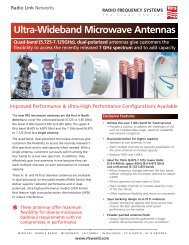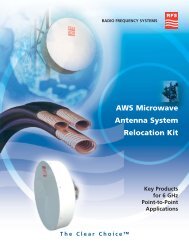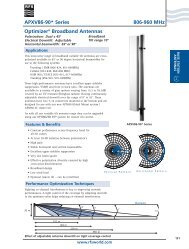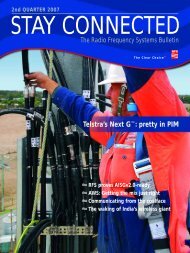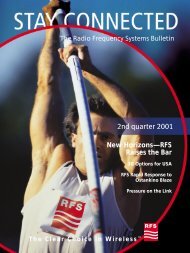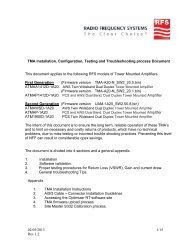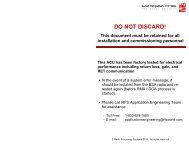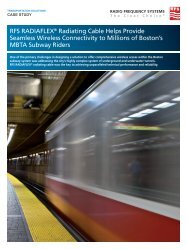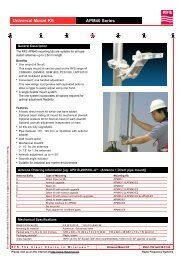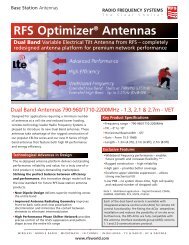download - Radio Frequency Systems
download - Radio Frequency Systems
download - Radio Frequency Systems
Create successful ePaper yourself
Turn your PDF publications into a flip-book with our unique Google optimized e-Paper software.
the industry bar in on-platform radio<br />
communications, by specifying 100 per<br />
cent RF coverage of all platform operations<br />
and maintenance areas.<br />
Up to 2001, Petrobras had used a<br />
‘passive repeater’ system to distribute<br />
the 450 MHz production and maintenance<br />
communications band about the platforms.<br />
This involved a network of antennas<br />
located across each of its platforms to<br />
distribute and re-distribute the signal. “It<br />
was a success in some areas, but not in<br />
others,” Cumin explains. “So we<br />
approached <strong>Radio</strong> <strong>Frequency</strong> <strong>Systems</strong> for a<br />
system guaranteed to achieve 100 per cent<br />
coverage.”<br />
group in its Sao Paulo centre, Amauri Soares,<br />
concurs with Dorst’s view, and cites the<br />
dense-packed nature of RF reflection and<br />
attenuation objects on each platform as a<br />
further challenge. “The platforms are all<br />
unique—they are all different,” he says.<br />
“Each deck area can measure as much as 120<br />
metres by 100 metres in area, with the deck<br />
crammed with metal machinery and rooms.<br />
There are many people moving about on the<br />
platform as well—often up to 110 personnel.<br />
The combination of the RF reflections caused<br />
by the metal objects, coupled with the<br />
prospect of RF ‘fades’ (caused by personnel<br />
as they move about the decks) makes for a<br />
challenging design environment!”<br />
Unique structures<br />
The project entailed innumerable<br />
challenges, not the least being the wide<br />
variety of platform structures that RFS<br />
had to address. In addition to Petrobras’s<br />
more conventional fixed platforms, it also<br />
requested RFS address RF communications<br />
on its two deepwater structural innovations:<br />
the ‘floating production storage and offloading’<br />
(FPSO) and the ‘semi-submersible’<br />
platforms. The FPSO is essentially a ship fitted<br />
out for drilling and product storage, and<br />
long-term at-sea location at the well site. The<br />
‘semi-submersible’, on the other hand, is a<br />
floating drilling unit fitted with pontoons and<br />
columns that, when flooded with<br />
seawater, cause the structure to submerge to<br />
a predetermined depth. Both the FPSO and<br />
the semi-submersible are moored to the<br />
seabed at the drilling location, and<br />
connected to the well by flexible risers.<br />
“What was interesting here, is that these<br />
structures really demanded a hybrid<br />
approach to the RF design,” explains RFS’s<br />
Vice President of Americas Wireless<br />
Distributed Communications <strong>Systems</strong> (WDCS),<br />
Ron Dorst. “The buildings on the multideck<br />
platforms are essentially similar to<br />
high-rise building structures. The columns<br />
and pontoons of the semi-submersibles, on<br />
the other hand, have much more in common<br />
with the many rail and road tunnels and<br />
metros that RFS has worked on throughout<br />
the world. So what we’ve had to do is<br />
combine our know-how from the road and<br />
rail sector with that of in-building, to come<br />
up with the optimal oil platform solution.”<br />
Chief designer with the RFS WDCS design<br />
From prototype to project<br />
The solution proposed by Soares and his<br />
team was based on realizing ‘contoured’<br />
RF coverage, tailored to achieve 100<br />
per cent coverage of the operations and<br />
maintenance points on each of the<br />
Petrobras platforms. RFS’s Stationmaster II<br />
omnidirectional antennas were proposed to<br />
achieve RF coverage in the open outdoor<br />
deck areas, while a network of RFS<br />
point-source omnidirectional indoor<br />
antennas were suggested for the platform’s<br />
closed deck areas. In these areas, the RF<br />
signal would be distributed via power<br />
dividers and directional couplers to ensure<br />
balanced coverage to all points.<br />
Feeder connections to each RF device<br />
would be achieved via RFS’s CELLFLEX<br />
foam-dielectric coaxial feeder cable. For<br />
the more tunnel-like areas of the<br />
platforms, such as the semi-submersible’s<br />
columns, pontoons and submarine deck,<br />
RFS proposed using its world-renowned<br />
RADIAFLEX RCF series broadband radiating<br />
cable to provide homogeneous RF<br />
distribution.<br />
On the basis of this proposal, Petrobras<br />
commissioned RFS in 2002 to develop a<br />
prototype system for the first of these<br />
platforms, an exploration drilling rig known<br />
at P23. “This was the first to use RFS’s<br />
distributed RF approach,” explains<br />
Petrobras’s Cumin. “The P23 prototype<br />
proved a success. The main gains [on<br />
this platform] related to the speed of<br />
communications and the assurance that<br />
every part of the platform was covered.<br />
For example, if you have to close a valve for<br />
Petrobras’s platform P25 is a semisubmersible<br />
platform located in the<br />
deep waters surrounding the<br />
Campos Basin’s Albacora oil field.<br />
7



